

What caused the decline of Harappa? Education Hub. Eurasian ChromoPainter Analysis. Posted by Zack on August 15, 2012 Some months ago, I decided to run a big ChromoPainter analysis of the Eurasian samples I have.

I removed from my dataset not only all Sub-Saharan Africans, but also North Africans and anyone else with more than 2% African admixture (which unfortunately included me). Since the number of samples was still too large, I picked 25 random individuals from each non-South-Asian ethnicity while keeping all South Asians. I also tried to remove all close relatives and those with a high missing genotyping rate. In the end, I had 254,576 SNPs for 2,001 samples belonging to 197 ethnic groups. I ran ShapeIT to phase their genomes and then ChromoPainter and fineStructure.
Then I got busy and the results sat on my computer for more than a month. Gobekli Tepe: World’s Oldest Temple, or Zoo? « Star in the Stone. Stone totem pole Older than Stonehenge.

Older than ancient Sumer. Older than Egypt. The Harappan State: Was it or Wasn't it? Free Essay on Seals of Harappa - Shalomf. Harappa. Distance Between Harappa And Jammu And Kashmir. Sidra Gulzar - Institutionen för historiska studier, Göteborgs universitet. Personal Information I am Sidra Gulzar from Pakistan.
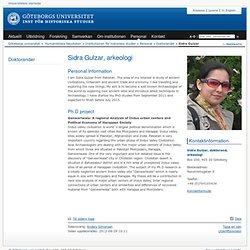
The area of my interest is study of ancient civilizations, Urbanism and ancient trade and economy. I like traveling and exploring the new things. My aim is to become a well known Archaeologist of the world by exploring new ancient sites and introduce latest techniques in Archaeology. I have started my PhD studies from September 2011 and expected to finish before July 2015. Ph D project. Indus valley civilization remains in haryana. Short essay on the Origin of Indus Civilization. Rare Indus seal discovered in Cholistan. The archaeologists team leader said the excavation revealed a circular platform at Sui-Vihar built with sun-dried bricks and a number of supporting walls to hold the platform and the cylindrical structure. – File Photo LAHORE, Feb 6: The Punjab University archaeology department has discovered a rare Indus seal in steatite material with carved figure of Ibex with two pictographs from Wattoowala, Cholistan, during a survey of different sites near Derawar Fort along the ancient bed of River Hakra.
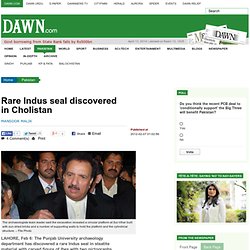
The seal dates back to 2500-2000 BC. The seal has been discovered by a six-member team of archaeologists headed by PU archaeology department chairman Dr Farzand Masih, who has just concluded a Unesco-funded US$26,000 project “Sui-Vihar Excavations and Archaeological Reconnaissance of southern Punjab”. Dr Masih told Dawn that the discovery would open new dimensions for scholars. Indus Script: A Study of its Sign Design.
One of the largest unicorn seals, found at Harappa in 1999.
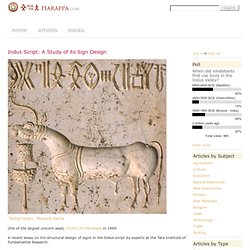
A recent essay on the structural design of signs in the Indus script by experts at the Tata Institute of Fundamental Research. Abstract. Arts / Books : Archaeo-metallurgy of Indus civilisation. Science and Metal Technology of Harappans: Edited by Deo Prakash Sharma; Kaveri Books, 4832/24, Ansari Road, New Delhi-110002.
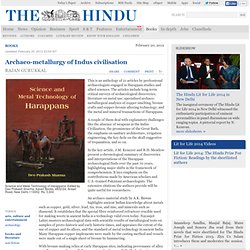
Rs. 3,500 This is an anthology of 21 articles by professional archaeologists engaged in Harappan studies and allied sciences. Harappa Culture Pictures of Ancient Indian Seals. Some Very Interesting Indus Valley Tablets The picture below is repeated many times, it makes reading the text alongside the picture easier.
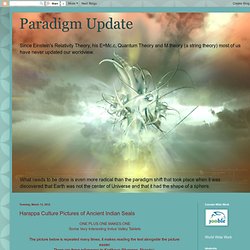
There are three references to Kartikeya (Muragan, Skanda). Royal Visit: Thai Princess visits Harappa. Did a Waning Monsoon Hit Harappa? A new study,of variations in the Indian monsoon over 10,000 years, by researchers at the Woods Hole Oceanographic Institution (WHOI) is shedding new light on the end of the Harappan civilisation.

According to a WHOI release: ‘The geological record and archaeological evidence tell a story of the possible fate of India’s earliest civilisations. Cultural changes occurred across the Indian Subcontinent as the climate became more arid after about 4,000 years. In the already dry Indus basin, the urban Harappan civilisation failed to adapt to even harsher conditions and slowly collapsed. But aridity favoured an increase in sophistication in central and south India where tropical forest decreased in extent and people began to settle and [undertake] more agriculture.
Educate public on rainwater harvesting. Rajendran Britto The pre-Socratic philosopher, Thales of Miletus (c.624-548 BCE), claimed that everything in the universe is made of water and resolves itself into water. None of us can deny the fact that water is everything and water is life. It is rather difficult to imagine the world without water. Sacred assemblage: The pottery of Sheherezade Alam. Sheherezade shares two decades of her craft, a selection of clay vessels dated between 1985 and 2011. 1.75cm by 14cm.

PHOTOS: SHEHEREZADE ALAM Koel Gallery’s cream-coloured, light-filled interiors carry an enchantment. One is reminded of an early pleasure, that of pinwheels spinning against an open wind. Such is the effect of a cursory glance. Governer calls on ASI to protect Assam heritage. Tourism in Pakistan. Harappan Relics Found in Haryana Village. Chandigarh, Apr 12 (IANS): Relics believed to be associated with the ancient Harappan civilisation have been dug out from a village in Haryana by archaeological experts from Cambridge and the Banaras Hindu University (BHU).

Extensive excavations at the ancient Tida Bud Teela, a mound spread out over 400 sq m area, in Khalsa Bohla village in Karnal district, 160 km from here, have led to the relics. "The relics include pottery, bones, mud wall, grain store and red-coloured utensils, which are believed to have been used by people belonging to the Harappan era," Arun Pandey, the excavation team leader, told IANS. He said the relics were found in the first few days of excavation that saw digging up to a depth of four metres. These have been sent for carbon-dating and other examination to know their exact period and whether these belong to the Harappan period. The excavation was initiated March 28 and would continue till April 16. Harappan relics found in Haryana village. Chandigarh, April 12, 2012, IANS: Excavation Archaeological experts from Cambridge and the Banaras Hindu University have dug out relics, believed to be associated with the ancient Harappan civilisation, from a village in Haryana.
Khirsara in Gujarat emerges prominent mature Harappan site. Khirsara lies about 85 km Northwest of Bhuj on the Bhuj-Narayan Sarover State Highway After three years of extensive excavation by the Archaeological Survey of India (ASI), Khirsara has emerged as the prominent mature Harappan site in western Kutch, showing how advance the trade from this part of Gujarat used to be around 4,600 years ago. "Khirsara has emerged as one of the most prominent mature Harappan settlements in Western Kutch. Earlier, Dholavira and Junikuren had emerged as prominent Harappan sites in Kutch," ASI's Superintendent Archaeologist, Vadodara, Dr Jitendra Nath said. Khirsara in Gujarat Emerges Prominent Harappan Site. New Specimen of Harappa found in Gujrat. Harappan Civilization - Dholavira. Art, culture can do wonders to improve Pak-India ties. Relics of Harappan civilisation found in Haryana village, IBN Live News. PTI | 07:04 PM,Apr 10,2012. Rediscovering the nonconformist.
Urdu poetry graduated from matters of the heart, or rather unrequited love, to contemporary social and political issues with Faiz Ahmed Faiz (1911 to 1984). Poets before him seldom found the inspiration to write on people and society. Harappa « Envisioning Future. Indus Valley Civilization / Harappan Civilization - 2300-1700 BC. The modern state of Pakistan was established on 14 August 1947, but the region it encompasses has an extensive history that overlaps with the histories of Ancient India, Iran and Afghanistan. Bones kill myth of happy Harappa - Study shows gender discrimination. Skip to comments. Bones kill myth of happy Harappa - Study shows gender discrimination Telegraph ^ | Monday , November 21 , 2011 | G.S. Dating sites: Photographic Prints of Archaeological site at Harappa dating from 3000 to 1700 BC from Robert Harding. Peeling the population genetic Indian onion.